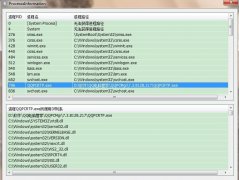C语言接口与实现方法实例详解(2)
一个高级类型是抽象的,因为接口隐藏了它的表示细节,以免客户调用程序依赖这些细节。下面是一个抽象数据类型(ADT)的规范化例子--堆栈,它定义了该类型以及五种操作:
#ifndef STACK_INCLUDED #define STACK_INCLUDED #define T Stack_T typedef struct T *T; extern T Stack_new (void); extern int Stack_empty(T stk); extern void Stack_push (T stk, void *x); extern void *Stack_pop (T stk); extern void Stack_free (T *stk); #undef T #endif
实现
包含相关头文件:
#include <stddef.h> #include "assert.h" #include "mem.h" #include "stack.h" #define T Stack_T
Stack_T的内部是一个结构,该结构有个字段指向一个栈内指针的链表以及一个这些指针的计数:
struct T {
int count;
struct elem {
void *x;
struct elem *link;
} *head;
};
Stack_new分配并初始化一个新的T:
T Stack_new(void) {
T stk;
NEW(stk);
stk->count = 0;
stk->head = NULL;
return stk;
}
其中NEW是一个另一个接口中的一个分配宏指令。NEW(p)将分配该结构的一个实例,并将其指针赋给p,因此Stack_new中使用它就可以分配一个新的Stack_T
当count=0时,Stack_empty返回1,否则返回0:
int Stack_empty(T stk) {
assert(stk);
return stk->count == 0;
}
assert(stk)实现了可检查的运行期错误,它禁止空指针传给Stack中的任何函数。
Stack_push和Stack_pop从stk->head所指向的链表的头部添加或移出元素:
void Stack_push(T stk, void *x) {
struct elem *t;
assert(stk);
NEW(t);
t->x = x;
t->link = stk->head;
stk->head = t;
stk->count++;
}
void *Stack_pop(T stk) {
void *x;
struct elem *t;
assert(stk);
assert(stk->count > 0);
t = stk->head;
stk->head = t->link;
stk->count--;
x = t->x;
FREE(t);
return x;
}
FREE是另一个接口中定义的释放宏指令,它释放指针参数所指向的空间,然后将参数设为空指针
void Stack_free(T *stk) {
struct elem *t, *u;
assert(stk && *stk);
for (t = (*stk)->head; t; t = u) {
u = t->link;
FREE(t);
}
FREE(*stk);
}
完整实现代码如下:
#include <stddef.h>
#include "assert.h"
#include "mem.h"
#include "stack.h"
#define T Stack_T
struct T {
int count;
struct elem {
void *x;
struct elem *link;
} *head;
};
T Stack_new(void) {
T stk;
NEW(stk);
stk->count = 0;
stk->head = NULL;
return stk;
}
int Stack_empty(T stk) {
assert(stk);
return stk->count == 0;
}
void Stack_push(T stk, void *x) {
struct elem *t;
assert(stk);
NEW(t);
t->x = x;
t->link = stk->head;
stk->head = t;
stk->count++;
}
void *Stack_pop(T stk) {
void *x;
struct elem *t;
assert(stk);
assert(stk->count > 0);
t = stk->head;
stk->head = t->link;
stk->count--;
x = t->x;
FREE(t);
return x;
}
void Stack_free(T *stk) {
struct elem *t, *u;
assert(stk && *stk);
for (t = (*stk)->head; t; t = u) {
u = t->link;
FREE(t);
}
FREE(*stk);
}
相信本文所述对大家的C程序设计有一定的借鉴价值。
- 上一篇:C语言内存对齐实例详解
- 下一篇:C语言位图算法详解





